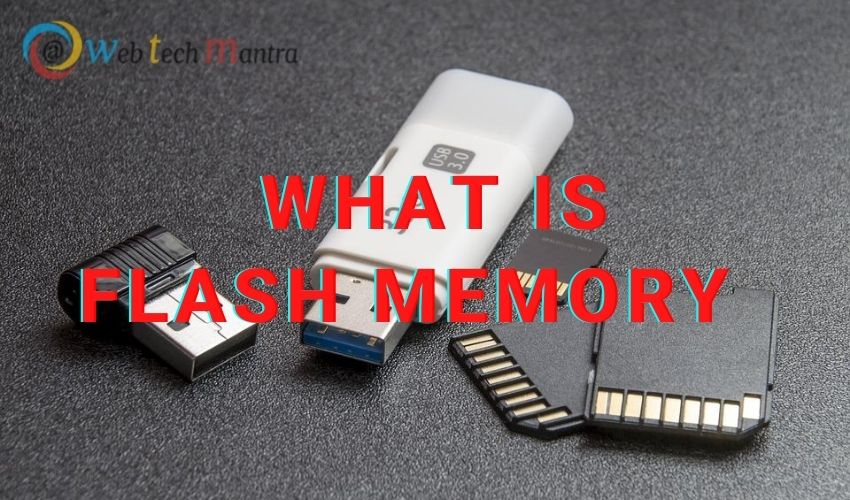What Is Flash Memory and How Can It Function

Definition – What Exactly Does Flash Performance Mean?
Check about flash memory, it is a nonvolatile memory processor utilized for storage and also for transferring data between a computer (PC) and electronics and other parts of the system. It’s got the power to be both reprogrammed and discharged.
Thank you for reading this post, don't forget to subscribe!Flash memory is a kind of erasable programmable read-only memory (EEPROM) but might also function as considered a standalone memory storage device like a USB disk drive. EEPROM is really a kind of information memory apparatus employing an electronic apparatus to edit or compose digital data. Flash memory can be another kind of EEPROM that is recovered and erased in huge blocks.
The flash memory comprises using floating-gate transistors to save data and more. Floating-gate transistors, or floating gate MOSFET (FGMOS), is comparable to MOS FET, and it really is a transistor applied for amplifying or shifting electronic signs. Flash memory resembles the normal MOSFET, but that the transistor includes two gates in the place of one.
What Is Flash memory?
Flash memory is a sort of nonvolatile memory which came to be from a mix of those conventional EPROM and E2PROM. Both of these kinds of memory have been only seen sporadically nowadays and other styles of memory, for example, Flash has obtained over.
Basically, flash-memory employs the exact same procedure of programming whilst the normal EPROM and the erasure way of this E2PROM.
One of the chief advantages that flash memory gets when put next to EPROM is its potential to be erased.
Nevertheless, it isn’t possible to disable each mobile very quickly memory separately unless a great number of additional circuitry is inserted into the processor. This might add somewhat to the price and so most manufacturers lost this process towards a system at which the whole processor, or even perhaps a massive portion of its block or flash – ergo the name.
Nowadays most flash memory processors have discerning erasure, allowing sectors or parts of their flash memory to be erased. Yet any erasure still usually means that a considerable section of this processor needs to be manually erased. Flash-memory has been called as a result of its capacity to erase a block of data at a flash” Dr. Masuoka’s aim was to produce a memory chip maintaining data once the power was switched off. Back in 1988, the Intel Corporation created the very first firm NOR-type flash processor, which replaced with the long-term memory called read-only memory (ROM) chip on PC motherboards comprising the simple input/output OS (BIOS).
Web Tech Mantra Explains Flash Memory
A flash memory processor consists of either NOR or NAND gates. Even the NOR gate port supports full addresses, data discs, and arbitrary use of some memory areas.
NAND was produced by Toshiba per year later NOR was born. It really is faster, has a cheaper per piece, necessitates less processor space per cell, and contains additional durability. At NOR gate flash every cell comes with a stop attached to a bit line and another end attached to a bottom line. In the event, the note line is “high” then your transistor proceeds to lessen the output line.
Flash-memory has lots of capabilities. It’s a good deal less costly compared to EEPROM and doesn’t need batteries to get storage such as static RAM (SRAM). It’s nonvolatile, includes an extremely rapid access time and has higher immunity to kinetic shock in comparison to your hard disk drive. Flash memory is incredibly durable and will withstand extreme anxiety or extreme temperature. It may be used to get an extensive variety of applications like digital cameras, cell phones, laptop computers, and PDAs (personal digital assistants), digital music players along solid-state drives (SSDs).
Flash-memory improvement report
Flash memory goes to approximately 1980 if the concept was designed in Toshiba by Dr. Fujio Masuoka.
The simple lab concept took a few years to produce into an item that can possibly be started commercially. Intel introduced the very first industrial processors in the industry in 1988 – those neither were NOR established types. Toshiba again established their technology further and could declare NAND technology at the 1987 IEDM. This tech, however, still needed further development to bring it to commercial launch.
The main benefit of NAND flash has been that it’d paid down hiding and write times plus it had an increased storage density.
Flash memory has grown somewhat big in the last several years and now is widely utilized in many software used as USB memory sticks, Compact Flash cards, SD memory cards, and other different types of memory cards as well as. Flash hard drives, also referred to as solid-state drives within many computers.
Related Terms
- Types of flash memory
- How does flash memory work
- Flash memory vs ssd
- Flash memory vs RAM
- Flash memory vs eeprom
- Flash memory meaning
- Flash memory – tutorialspoint
- Flash memory in micro controller
- Static Random Access Memory (SRAM)
- Dynamic Random Access Memory (DRAM)
- Metal-Oxide-Semiconductor Field-Effect Transistor (MOSFET)
- NAND Gate
- Elastic Block Flash (EBF)
- Solid State Drive (SSD)
- Virtual Memory (VM)
- Motherboard
- Smartphone
- Read-Only Memory (ROM)
- How does flash memory work
- Flash memory examples
- Flash memory card
- Page navigation
